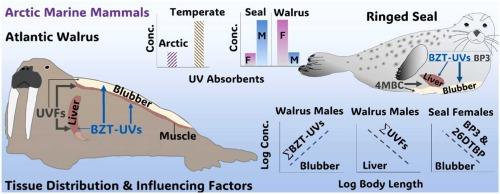Tissue distribution of ultraviolet absorbents and industrial antioxidants in Atlantic walruses (Odobenus rosmarus rosmarus) and ringed seals (Pusa hispida) from the Canadian Arctic: Influence of sex, body size, and spatial variation
IF 11.3
1区 环境科学与生态学
Q1 ENGINEERING, ENVIRONMENTAL
引用次数: 0
Abstract
UV absorbents and industrial antioxidants are contaminants of emerging concern. However, their tissue distribution in marine mammals remains poorly characterized. This study investigated the tissue distribution of benzotriazole UV stabilizers (BZT-UVs), organic UV filters (UVFs), 2,6-di-tert-butylphenol (26DTBP), and aromatic secondary amines (Ar-SAs) in Atlantic walrus (Odobenus rosmarus rosmarus) (blubber, muscle, and liver) and ringed seal (Pusa hispida) (blubber and liver) tissues collected around several communities in the Canadian Arctic. In both species, blubber accumulated higher levels of BZT-UVs than other tissues, whereas some UVFs, such as benzophenone and 2-hydroxy-4-methoxybenzophenone (BP3), accumulated more in the muscle or liver of walruses. ∑BZT-UVs in male walrus blubber correlated positively with body length, demonstrating a bioaccumulation trend as individuals grew larger. This contrasts with the evidence of growth dilution observed for ∑UVFs in male walrus liver, and for BP3 and 26DTBP in female ringed seal blubber. Both species exhibited spatial variation in UV absorbent concentrations. This study provides the first data on the tissue distribution of these contaminants in Arctic marine mammals, revealing tissue-, spatial-, sex-, and compound-specific distribution patterns. The findings offer current reference data to support environmental monitoring, risk assessment, and management efforts, particularly for species important to northern Indigenous communities.

加拿大北极大西洋海象(Odobenus rosmarus rosmarus)和环斑海豹(Pusa hispida)紫外线吸收剂和工业抗氧化剂的组织分布:性别、体型和空间变异的影响
紫外线吸收剂和工业抗氧化剂是日益受到关注的污染物。然而,它们在海洋哺乳动物中的组织分布特征仍然很差。本研究调查了在加拿大北极地区几个群落收集的大西洋海象(Odobenus rosmarus rosmarus)(脂肪、肌肉和肝脏)和环斑海豹(Pusa hispida)(脂肪和肝脏)组织中苯并三唑紫外线稳定剂(bzt -UV)、有机紫外线滤光剂(UVFs)、2,6-二叔丁基酚(26DTBP)和芳香仲胺(Ar-SAs)的组织分布。在这两个物种中,鲸脂比其他组织积累了更高水平的bzt - uv,而某些UVFs,如二苯甲酮和2-羟基-4-甲氧基二苯甲酮(BP3),在海象的肌肉或肝脏中积累了更多。雄性海象脂肪∑bzt - uv与体长呈显著正相关,随着个体的成长呈生物积累趋势。这与雄性海象肝脏中的∑UVFs以及雌性环斑海豹脂肪中的BP3和26DTBP的生长稀释证据形成对比。两种植物的紫外吸收浓度存在空间差异。这项研究提供了这些污染物在北极海洋哺乳动物组织分布的第一个数据,揭示了组织、空间、性别和化合物的特定分布模式。研究结果为支持环境监测、风险评估和管理工作提供了当前的参考数据,特别是对北部土著社区重要的物种。
本文章由计算机程序翻译,如有差异,请以英文原文为准。
求助全文
约1分钟内获得全文
求助全文
来源期刊

Journal of Hazardous Materials
工程技术-工程:环境
CiteScore
25.40
自引率
5.90%
发文量
3059
审稿时长
58 days
期刊介绍:
The Journal of Hazardous Materials serves as a global platform for promoting cutting-edge research in the field of Environmental Science and Engineering. Our publication features a wide range of articles, including full-length research papers, review articles, and perspectives, with the aim of enhancing our understanding of the dangers and risks associated with various materials concerning public health and the environment. It is important to note that the term "environmental contaminants" refers specifically to substances that pose hazardous effects through contamination, while excluding those that do not have such impacts on the environment or human health. Moreover, we emphasize the distinction between wastes and hazardous materials in order to provide further clarity on the scope of the journal. We have a keen interest in exploring specific compounds and microbial agents that have adverse effects on the environment.
 求助内容:
求助内容: 应助结果提醒方式:
应助结果提醒方式:


